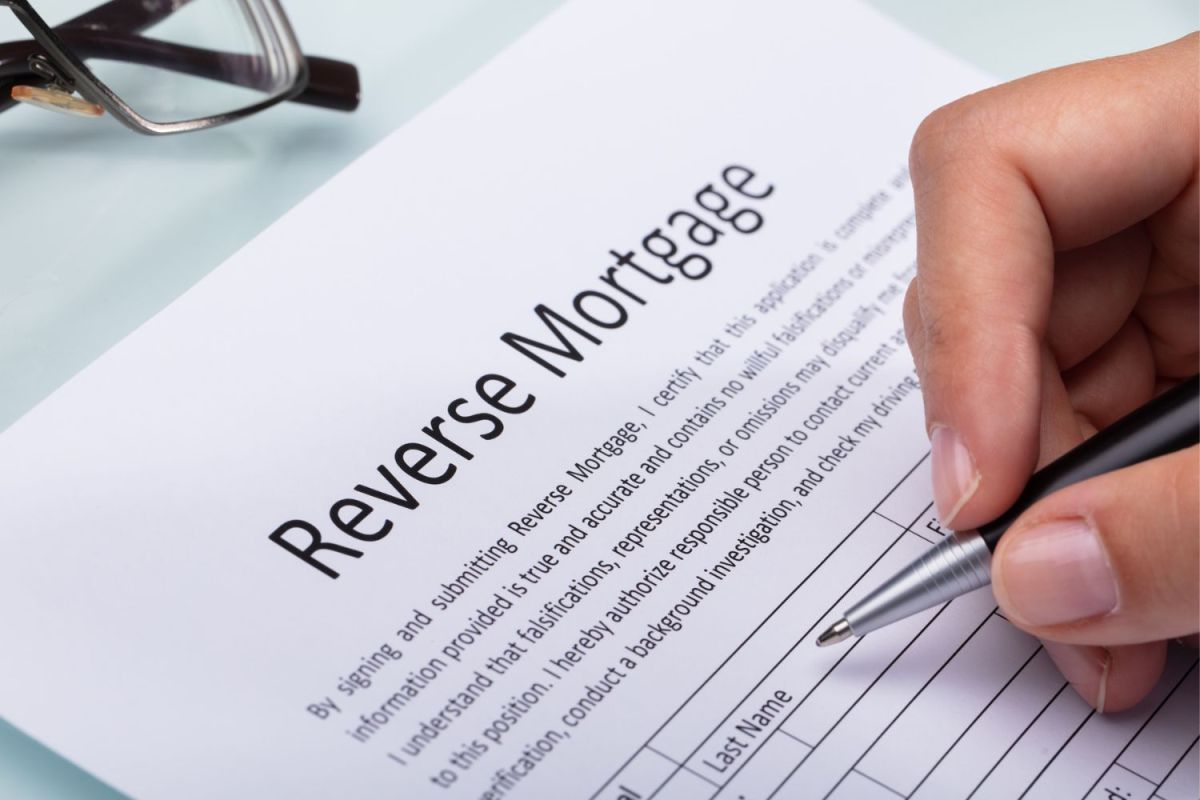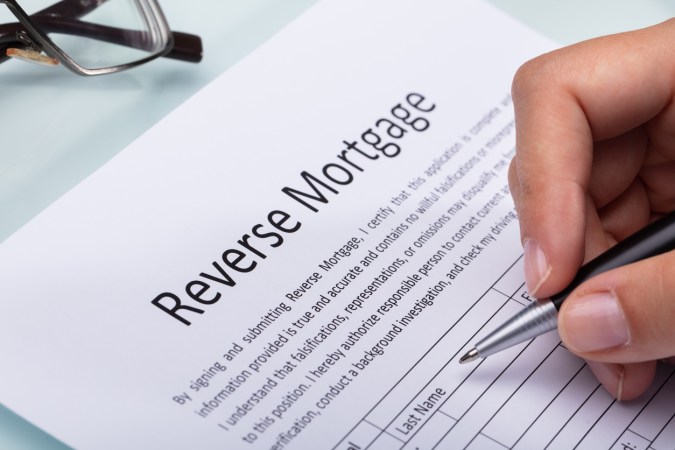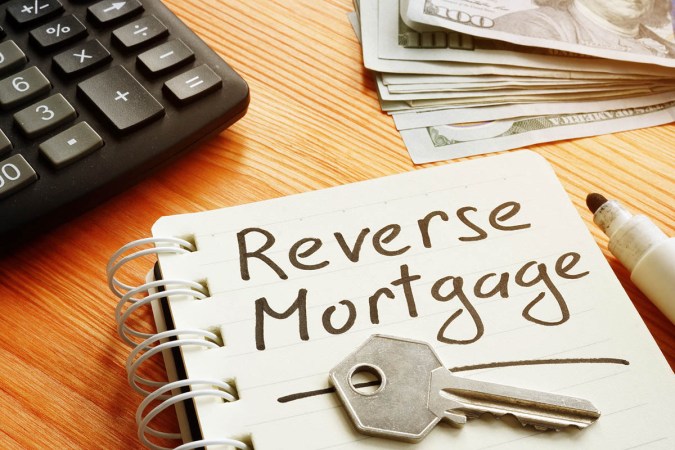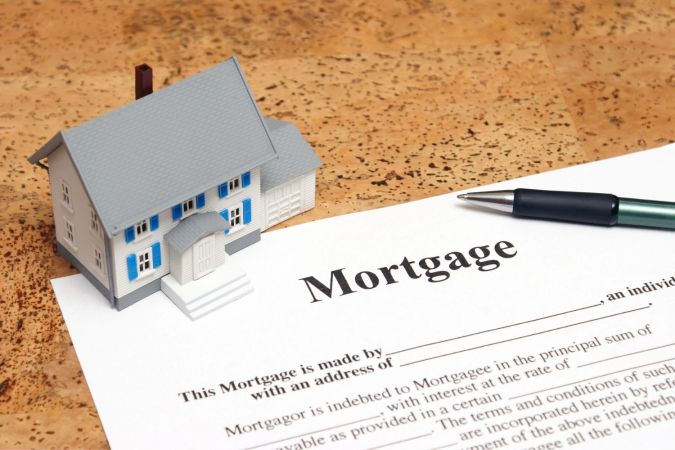We may earn revenue from the products available on this page and participate in affiliate programs. Learn More ›
Q: We retired a few years back, and because of some changes in our investments we find that we’re a little more pinched financially than we expected we would be. We’d like to be able to relax and enjoy our retirement without worrying so much. We do have a lot of equity in our home, and our neighbor recently explained that he’s taken a reverse mortgage to have more access to day-to-day funds. What is a reverse mortgage? How does a reverse mortgage work?
A: Congratulations on your retirement, and on looking for creative solutions to your financial situation. The answer to the question of “What is a reverse mortgage?” is a little complicated. A reverse mortgage takes the concept of a home purchase mortgage, where borrowers offer up their to-be-purchased home as collateral for a sum of money they use to buy it, then immediately begin repaying the mortgage until they own the house fully. Reverse mortgages begin with a homeowner who already either owns the home outright or has a significant amount of equity in the home, who offers up their home as collateral for a sum of money they can use for whatever they need—renovations, outstanding medical bills, groceries, a cruise vacation—with the understanding that the loan need not be repaid until they sell the home, move out, or pass away. At that time, either the heirs or the estate will have the option to turn the property over to the lender in repayment, sell the home to pay off the balance of the loan, or refinance into a traditional mortgage loan to pay off the debt and keep the property.
Why would someone who has already paid off their home want to take a reverse mortgage? It’s pretty simple: The cost of living in retirement isn’t low, and many people are underprepared. As the market has fluctuated in past years, many peoples’ savings have taken a hit. Then there’s the unexpected—medical costs, unforeseen repairs, car problems, and other expenses that are manageable when a regular full paycheck is deposited every 2 weeks, but are tougher when relying on depleted savings or a too-small Social Security check. In other cases, homeowners have spent a lifetime responsibly paying down debt, have several hundred thousand dollars invested in their home, and want to live a little—and aren’t concerned about leaving their home to family after they pass away. In all of these cases, a reverse mortgage can be a great option.
Reverse mortgage requirements are strict but straightforward. Borrowers must be over the age of 62 and must have a great deal of equity in their home—or have paid it off entirely. Lenders will assess the borrower’s credit to make sure they’re not carrying a significant amount of debt that would exceed the amount of the reverse mortgage, but the requirements will vary by lender. The property must be the borrower’s primary residence, and if the loan is backed by the Federal Housing Administration (FHA), the property must also meet standards that demonstrate the property is in good condition and doesn’t present a health risk to the residents.
There are, however, some drawbacks and some cases in which a reverse mortgage may not be the right choice for a homeowner. This field has become somewhat notorious for scam artists preying on vulnerable, cash-strapped seniors, so it’s important to make sure the lender is reliable and the loan is backed by the federal government. It’s also a good idea to read all documents carefully to make sure that the homeowner understands the requirements and conditions of the mortgage.
Retirees and older adults can use a reverse mortgage to pull equity from their home—under the right circumstances.
How do reverse mortgages work? Reverse mortgages take the equity in a home, or the market value of the home minus any existing mortgages, and turn it into a source of income for the home’s owner that must be repaid at the end of the loan period. Home equity loans work similarly, but the repayment period on a home equity loan begins almost immediately. In a reverse mortgage, the loan period ends and repayment begins only when the homeowner either passes away or moves out of the home, and the most frequent method of repayment is either a transfer of ownership directly to the lender or the sale of the home with the proceeds repaying the loan. This can be a boon for homeowners over the age of 62 who have a fair amount of equity but whose available cash flow is limited. It’s important to note that the homeowner is still responsible for paying property taxes and insurance premiums on the home, and it’s especially important to note that the loan does accrue interest over time, so the paid-out amount will not be the repayment total at the end of the loan. Also critical: The home itself is the collateral, so if there’s a problem—unpaid taxes or failure to adhere to the terms of the loan—the reverse mortgage company may foreclose on the home and seize it.
A reverse mortgage can be a great way to draw cash out of the investment older adults have made into their home—but as with any financial transaction, it is incredibly important to make sure that the terms and regulations are clear and make good sense for the individual’s specific financial situation before signing any documents.
Tapping into home equity can help homeowners pay their retirement expenses.
Many retirees discover at some point that they underestimated the cost of living without a regular paycheck. Others realize that the cost of living has shot up faster than they anticipated and see their savings running down, or they experience unanticipated medical or repair expenses. Reverse mortgages, especially home equity conversion mortgages (reverse mortgages backed by the Federal Housing Administration, or FHA), which aren’t restricted in terms of their use, can help homeowners who have sunk years of earnings into purchasing and maintaining their homes use some of that investment to support their financial needs in retirement.
Borrowers can avoid depleting their retirement savings too quickly by using reverse mortgage funds.
For many homeowners, the shift from full-time employment to retirement means they will suddenly be spending much more time at home, which can trigger a sudden recognition that there are parts of the home that need renovation or improvement. But most retirement savings exist as investments, with a certain amount drawn off the top each month to finance the retiree’s daily living expenses. Withdrawing a significant amount from the principle to pay for new windows, a kitchen renovation, or the installation of accessibility safeguards can be a poor financial approach—not only will the withdrawal reduce the balance of the savings significantly, but the homeowner will no longer earn interest on those savings, so it’s a loss of immediate cash and future earnings. A reverse mortgage can provide the cash for improvements and other expenses while allowing the homeowner to repay the loan gradually, rather than drawing down the base of their savings all at once.
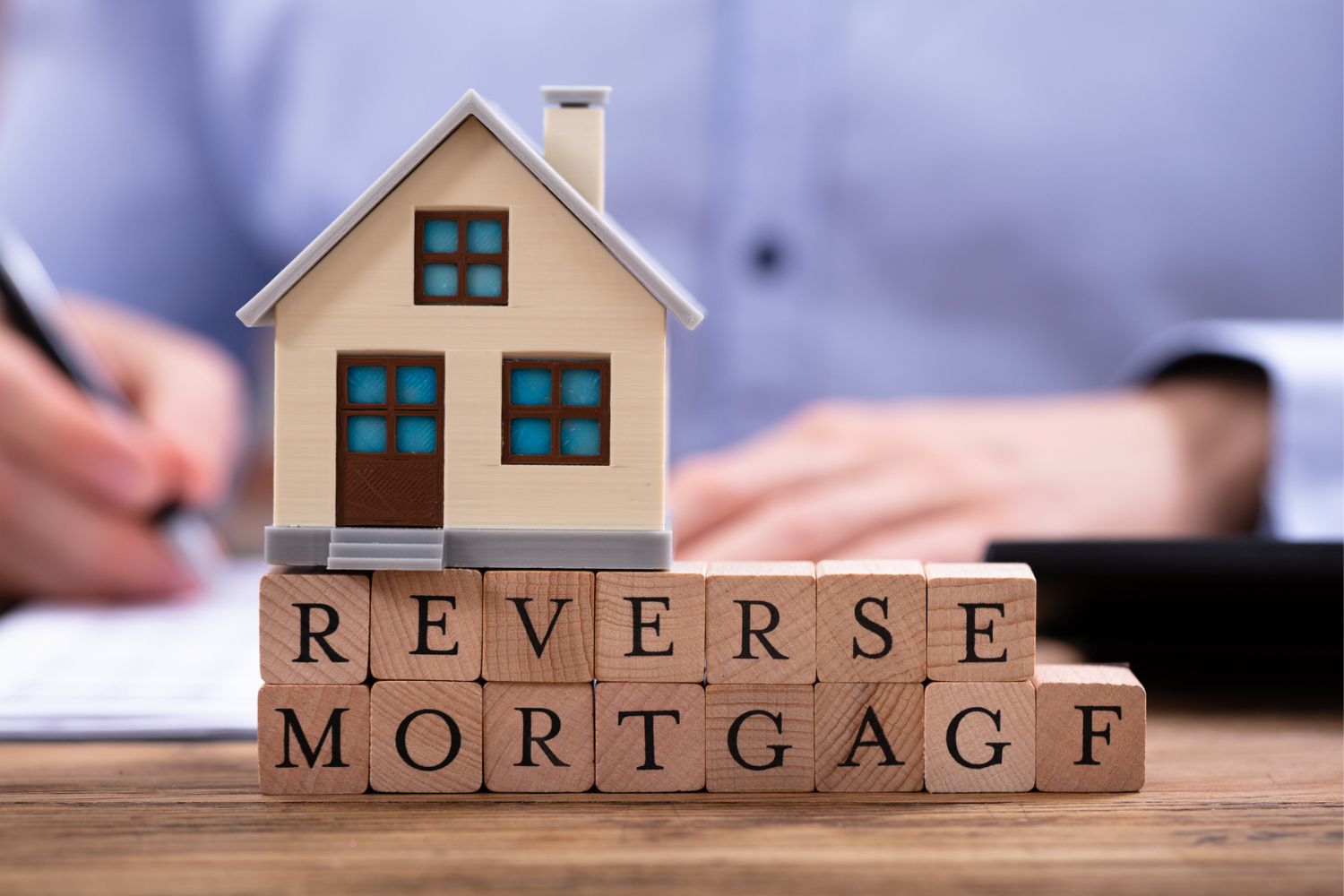
Homeowners can use those funds any way they like to.
Necessary home improvements or medical expenses are easily justifiable reasons for taking out a reverse mortgage, but what if an older homeowner simply wants to travel the world? In most cases, the homeowner doesn’t have to justify the reason they want to take out the reverse mortgage, meaning the purpose of the loan is their own business, so there’s no reason not to use the equity in the home to travel or help finance a new car.
In addition, reverse mortgage funds can be used for basics—groceries, bills, lawn-care services—any of the expenses that seem small individually but can easily become overwhelming in retirement.
One type of reverse mortgage, called a single-purpose reverse mortgage, does have some limitations. For this type of mortgage, the homeowner takes the mortgage for a specific purpose, and the lender dictates how the money can be spent in the terms of the loan. Violation of those terms can result in foreclosure, so it’s important to pay close attention to the rules. These are less common loans and are usually offered through state or local organizations or nonprofits, and they may be more readily available for borrowers with less equity or less-than-ideal credit.
And borrowers don’t need to make monthly mortgage payments on a reverse mortgage.
Reverse mortgages are, quite literally, the reverse of a standard mortgage: The lender will disburse the funds either in a single lump sum, in monthly installments, or as a line of credit. Borrowers do not need to begin repayment until the property is transferred, or until the borrower passes away, at which point the borrower’s estate will be responsible for the balance.
Borrowers won’t owe income taxes on their reverse mortgage funds, either.
The greatest benefit of a reverse mortgage is that the homeowner continues to live in the home while drawing a financial benefit from the equity, rather than selling the home to access those funds, but there’s another benefit to not selling. Because the reverse mortgage is a loan, not a sale, there’s no tax on the funds. The money isn’t counted as income because it must be paid back, and there’s no sales tax because the property hasn’t been sold. While some are skittish about reverse mortgages because of the risk to the home and feel that an outright sale is the safer bet, the nontaxable status of the money drawn from a reverse mortgage is in some cases an enormous savings that makes the risk worthwhile if the homeowner appropriately researches the lender and the reverse mortgage terms before signing. These benefits can be somewhat offset by the closing costs and origination fees on the reverse mortgage itself, but for those who are on the fence between selling and taking a reverse mortgage, it’s a benefit worth considering.
In some cases, homeowners may never even repay the full loan amount on their reverse mortgage.
Payment on a reverse mortgage isn’t due to begin until the borrower sells or transfers the property to someone else or passes away. Homeowners who don’t plan to pass their home to children or family through a will can take a reverse mortgage with no intention of ever paying back the loan at all—and that’s perfectly acceptable. In that case, the property would transfer to the reverse mortgage lender at the time of the borrower’s death, and the company would then sell the home to recoup its loan amount.
In addition, while the loan balance will grow over time as interest accrues on top of the principal balance, the amount to be repaid cannot exceed the actual value of the home. Should the borrower choose to repay the loan early or if the borrower’s heirs should choose to repay the loan rather than transferring the property to the lender, the repayment amount is limited to the current market value. Both the borrower and their heirs are prevented from being “underwater” (where the borrower owes more on their mortgage than the home is worth) with their reverse mortgage, which is an excellent protection for borrowers who take the reverse mortgage when home values are high, but whose home loses value over the course of the loan period through market fluctuations. Should the home’s value be less than the amount to be repaid, lenders will be protected as well: The Federal Housing Administration guarantees most reverse mortgages, so it will cover any losses the lender incurs.
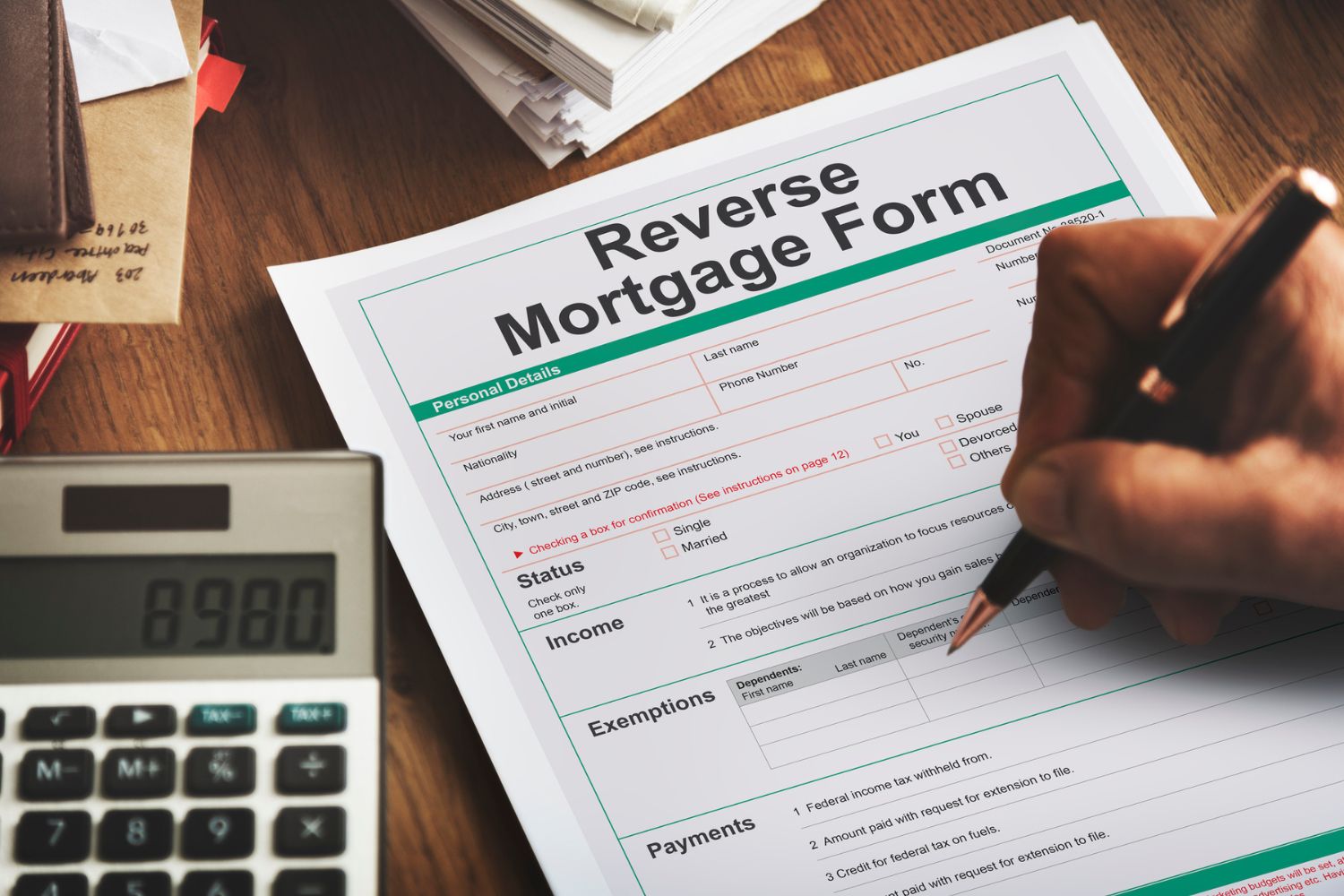
Borrowers—or their heirs—will need to pay the loan in full if the property changes hands, though.
In some cases, reverse mortgage documents declare that the property will automatically transfer to the lender upon the death of the borrower. Other loan documents do not: The property remains in full control of the borrower, and the loan doesn’t enter repayment unless the borrower sells or transfers the property or their life ends. Many borrowers prefer this option, as the house remains completely “theirs” until they wish to sell or they pass away.
However, as people age, many families choose to transfer properties directly to their heirs for tax purposes and for simplicity: If a homeowner’s child or agent handles most of the homeowner’s bill payments or financial matters, it makes sense to transfer the property into that person’s name. When a homeowner leaves the home to an heir, the property will transfer into the heir’s name. Unfortunately, any sale or transfer in the property records will mean that the reverse mortgage must immediately be paid back. The lender’s contract is with the homeowner, not their heirs or agents, so if the property no longer belongs to the homeowner, the lender loses its collateral and will call in the loan. At that time, the homeowner (if they’re still living) or their heirs or agents can choose to sell the home and repay the loan, refinance the loan, or transfer ownership of the home to the lender as repayment.
The loan balance will also need to be repaid if the borrower downsizes—moving into a retirement community or assisted living facility, for instance.
Reverse mortgages don’t place limits on how long the borrower can wait to begin repayment, which is why they work so well for older adults and retirees. The loan period is limited by the lifespan of the borrower, and since reverse mortgages are available to homeowners over the age of 62, that may be quite a long time. This is one of the biggest risks of a reverse mortgage; while a healthy 62-year-old borrower may plan to remain in their home for the rest of their life, it’s difficult to know how things will look 15 or 20 years in the future. Health concerns or infirmity may make it impossible for the homeowner to keep up with a larger home, and moving to a smaller home might make sense. Assisted living or long-term care facilities may become necessary. In most cases, such moves will result in selling the home bearing the reverse mortgage.
After the sale, the loan will need to be repaid. This can be difficult financially, as in this case the proceeds from the home sale may be needed for the purchase of the new residence or to afford care in a facility. It’s a consideration that can be difficult to calculate at the time a reverse mortgage is taken.
A reverse mortgage isn’t free, either—borrowers will owe interest, mortgage insurance, and closing costs on the loan.
While in many ways reverse mortgages are ideal for tapping an investment made over years of homeownership and increasing cash flow, it’s important to remember that it is, in fact, a loan—a loan with a long period before repayment begins. That means it comes with all of the expenses borrowers will see with a home purchase mortgage: closing costs, legal fees, mortgage insurance premiums to protect the lender’s investment, and interest. The up-front costs can be rolled into the mortgage itself, but it’s important to balance these costs against the amount of equity in the home and the length of time the homeowner expects to remain in the home to determine if the expenditure is worthwhile. Though reverse mortgage rates are typically low, there is sometimes a decision to be made between a fixed-rate reverse mortgage, which feels more stable for many borrowers especially when rates are low but may limit that amount that can be borrowed, or variable-rate reverse mortgages, which can cause a spike in interest rates when the market fluctuates.
In addition, reverse mortgages use the home as collateral, so foreclosure is possible.
Just as with a traditional home-purchase mortgage, lenders need to protect their financial outlay, and the home itself acts as the collateral. When home-purchase mortgage borrowers default on their payments, the lender can foreclose and seize the home to sell and recoup its losses. The same can happen with a reverse mortgage even though the borrower isn’t making payments—there are terms to every loan that must be followed, and if the borrower violates those terms, the lender can foreclose. Examples of violations could be falling behind on property taxes, failing to keep the home in good repair, or failing to maintain homeowners insurance coverage. In addition, the home on which the reverse mortgage is drawn must be the borrower’s primary residence. Should the borrower move to another home without selling or transferring ownership of their mortgaged home, they can be found in violation of the reverse mortgage terms.
In some cases, taking out a reverse mortgage could jeopardize homeowners’ Medicaid or Supplemental Security Income status.
Social Security payments and Medicare are entitlement programs, meaning that the beneficiary has earned the amount of Social Security they’ll receive and Medicare benefits through a lifetime of contributions. Those benefits aren’t affected by other incomes, assets, or savings. Other programs designed to support older adults and retirees, on the other hand, are means tested, which means that in order to qualify for the benefit, a person must meet specific income criteria, and the amount of benefit received may be affected by other income or assets.
Medicaid and Supplemental Security Income are two of those programs, and as a result, the financial boost provided by a reverse mortgage may affect a borrower’s eligibility for those benefits. Those who qualify for these programs or other means-tested programs will want to work with their benefit counselors or meet with a financial adviser in their state to make sure that the potential benefit loss is worth taking out a reverse mortgage.
Scammers may use reverse mortgages as a pretense to defraud homeowners.
Unfortunately, unscrupulous people often target the elderly, assuming that because people are older they will be more trusting or vulnerable to scams. Even more unfortunately, these unscrupulous people know how to target their audience. Many retirees do have financial concerns, and a smooth talker who throws around lots of technical terms and promises a carefree, peaceful later chapter of life without worrying about finances can easily persuade a homeowner who isn’t familiar with the fine print to sign a predatory document. Sometimes the scam is artful enough to draw in homeowners who do know better. Inappropriately high interest rates, terms that are limited by a set number of years prior to repayment, documents that sign over the ownership of the home, documents that excessively limit the use of the funds—all of these can be written into the terms of a reverse mortgage loan and sold as something that will benefit the homeowner.
Is a reverse mortgage a ripoff? Most of the time, no—it can be a great option to supplement retirement savings and ease the financial burdens on older homeowners. Reverse mortgages do, however, require a significant amount of due diligence on the part of the homeowner and their families or advisers. Making sure that the lender is providing loans backed by the federal government and affiliated with a reputable bank or loan servicer is a good first step to avoiding scams. Even then, listening to your gut is important. Homeowners should never feel pressured to take a reverse mortgage, and they should never be told that a reverse mortgage is the only way to manage their finances. If something feels wrong or seems too good to be true, ask for clarification, and if it still feels off, talk with another lender.
After weighing the pros and cons of reverse mortgages, homeowners may consider contacting multiple lenders to check rates and terms.
Reverse mortgages can be a great option—or not—and the decision is usually more complicated than it may seem. Ideally, homeowners should research the best reverse mortgage companies (such as American Advisors Group and Longbridge Financial) including local banks, national banks, credit unions, and mortgage-only lenders. After identifying the lenders that feel comfortable and seem to have programs that meet the need, homeowners will want to consult with several to ask about their terms, limitations, rates, and conditions and ask for quotes. Because the details can be complex, it’s very helpful to have the specifics of each lender’s reverse mortgage explained by a person, not a website, so the homeowner can ask questions and have a reference point. As with other home-related loans, allowing several lenders to access a credit report within a single 30-day period will not adversely affect a credit rating, and permitting this can give homeowners specific information, rather than general information, about the costs and payouts of their options so they can select the reverse mortgage that will benefit them most.

